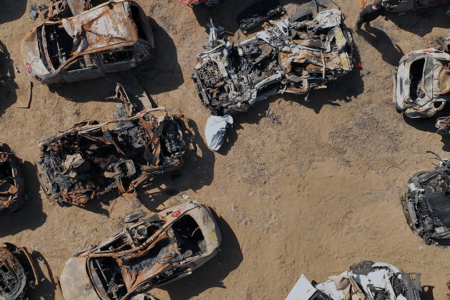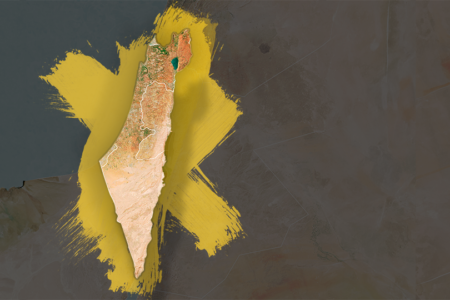The Fall and Rise of Israel
The land and people called Israel comprise a major unifying theme running through the Scriptures. It was Israel the PEOPLE whom God chose to be the recipients of special revelation, the penmen of the inspired Scriptures, and the kinship line of the divine incarnation. It was Israel the LAND which God designed to cradle and mature His people while also providing a place called Golgotha with a nearby rock-hewn tomb for divine expiation of human sin. Promises and prophecies, both fulfilled and unfulfilled, adorn the chosen people and the promised land called Israel.
Because Israel is so strategic in God’s eternal plan, considerable Scripture details its vicissitudes. It is the purpose of this brief monograph to outline the fall and rise of Israel, both land and people, as set forth in but one remarkable passage, Ezekiel Chapter 36.
I. The Fall of Israel.
Clearly the first 7 verses announce the conquest of the Land and the deportation of its people. These simple facts in themselves are not surprising. At the time of writing, Ezekiel was himself a hostage of the insatiable Babylonians and living in the enemy’s land (Ezekiel 1:1). The demise of Judah and the destruction of its renowned temple in 586 B.C. likely took place within 5 years of the prophecy. Judah’s sin was flagrant (w. 16-18); therefore divine judgment was imminent. The Babylonians under Nebuchadnezzar were to be the human instruments used by God to chasten His people who had defiled His Land.
Or were they?
A closer examination of the details in this remarkable prophecy discloses features which were not fulfilled by the Babylonian conquest. Only subsequent history of the area and its people reveals the incredible insight which this prophet manifested. Clearly he was instructed by God who alone knows perfectly all things past, present, and future. Consider three important details concerning Israel’s fall as revealed in w. 1-7.
1. The Identification of the Conqueror.
Ezekiel did not limit the conquest of the land nor the dispersal of its people to one nation. Verses 3-6 speak of nations as the instruments of conquest. This would imply that the land of Israel was to remain under the yoke imposed by several Gentile nations for an indefinite time. Likewise vv. 19, 24 reveal that the people of Israel were to be scattered among several nations. This prophecy obviously goes beyond the Babylonian conquest and the ensuing captivity period. The subsequent history of Palestine, however, clearly demonstrates the accuracy of the prophet’s words. The list of nations which have possessed the land of Israel and contributed to the scattering of its people is long and impressive.
Babylon 587-539 B.C.
Persia 539-332 B.C.
Greece 332-300 B.C.
Ptolemaic (Egyptian) Empire 300-198 B.C.
Seleucid (Syrian) Empire 198-168 B.C.
Rome 63B.C-320A.D.
Byzantine 320-636 A.D.
Arab 636-1072 A.D.
Seljuk 1072-1099 A.D.
Crusader 1099-1187 A.D.
Saracen 1187-1291 A.D.
Mamluk 1291-1517 A.D.
Ottoman Turk 1517-1917 A.D.
Great Britain 1917-1948 A.D.
Fourteen different peoples have possessed the land of Israel over the past 2500 years. Jewish sovereignty over the Land during that long period was limited to the Maccabean (Hasmonean) Period (168-63 B.C.) and the much briefer periods during the first (66-70) and second (132-135 A.D.) Jewish Revolts. These historical facts are in complete accord with both the spirit and the letter of the prophet’s assertion “Ye (the Land) might be a possession unto the residue of the nations. . .” (v. 3).
2. The Condition of the Conquered. According to vv.. 3 and 4 the land of Israel was to be made desolate. Since deserted cities are mentioned separately, this must refer to the land itself. First described in both Scripture and Egyptian literature as a “land of milk and honey,” Israel was to lose that productive capacity. Although the Babylonian conquest resulted in the land becoming fallow, its fertility was quickly restored by those returning from captivity. For centuries after the prophecy Israel continued to be a moderately productive agricultural land. During the Roman period Judea was considered to be one of the choice provinces in the entire empire. Serious fulfillment did not begin until the 7th century A.D., 1200 years after the prophecy was made. It was then that nomadic Arab folk, stirred by their newly-found Islamic faith, brought their flocks of sheep and goats into the rich lands of Israel. Centuries of unrestricted animal husbandry allowed the grasses to be nibbled away and the trees destroyed, thus exposing the naked soil to the mercy of the scorching sun and the erosive rain. This desolation of the Land was accelerated when the.Ottoman Turks took over in 1517. Mismanagement and absentee landlordism were not kind to the impoverished soil of Israel. The climax came during the latter days of World War I when the Turks cut down the surviving trees to fuel their desperate war effort. Today’s visitor to Israel is perplexed by the barren and rocky condition of its terrain which stands in stark contrast to the “milk and honey” description found in the Scriptures (Ex. 3:8). That confusion is resolved by an understanding of the historical fulfillment of Ezekiel’s precise prediction, “. . . they (the enemies) shall make you desolate” (v.3).
3. The Rectification of ihv Conquest. Verses 6 and 7 speak of a drastic change. Instead of the land bearing all of the judgment “the nations that are about you, they shall bear their shame.” The most obvious historical fulfillment of this prophecy is seen in the fact that all of the conquerors of the Promised Land have themselves become victims. The mighty Babylonians who plundered the Land and destroyed the temple barely lasted two generations before succumbing to the Persians, who, in turn, fell to the Greeks under Alexander the Great. The sequence in which each conqueror of the Land was in turn conquered continued over the entire 2500 year span. The last world power to taste the bitter frustration of occupying that special Land was the British Empire. Their attempts to pacify both the Jewish and Arab communities in the Land proved futile and contributed substantially to the demise of the empire. Surely the nations “shall bear their shame.”
In a special way it is possible that the prophecy is also being fulfilled through the conditions in the Middle East prevailing today. Consider the identity of the nations that are about you. To the north of Israel is Lebanon, a nation recently torn apart by a bloody civil war. To the northeast is Syria, twice humbled by Israel in the past nine years. Jordan to the east and Egypt to the southwest have both suffered severe economic and military reverses. Certainly Ezekiel’s words appear as current as today’s newspaper.
II. The Rise of Israel.
Beginning with the 8th verse Ezekiel describes the rise of Israel. There are three stages which the prophet delineates: the restoration of the Land to fertility, the restoration of the nation to the Land, and the restoration of the people to the Lord. The despoilment of the Promised Land, the worldwide scattering of the Jew, and the spiritual blindness of God’s chosen people are all temporary manifestations of human perversity and divine judgment.
1. The Restoration of The Land to Fertility The very adversative but with which v. 8 begins signals a drastic change. Verses 8-11 describe a Land which had been impoverished now being miraculously productive, The Land “shall shoot forth its branches,” it shall yield its fruit, its “cities shall be inhabited, and the wastes shall be built.” It shall become a better Land than it was at the beginning.
Although the complete fulfillment of this prophecy awaits the coming of the Messiah to establish His earthly kingdom, consider what has taken place during recent decades. When the state of Israel was established in 1948, of the 8000 square miles it possessed, only 412,000 acres were under cultivation. Within this cultivated area 75,000 acres were irrigated. By 1974 the amount of cultivated area had risen to 1,128,000 acres and the irrigated portion to 453,600 acres. Military occupied areas are not included in these statistics. Since only the original 8000 square miles of Israel are considered, the gains are substantial. Swamps such as Lake Huleh in Upper Galilee have been drained, rock-strewn fields cleared, and parched fields in the Negev irrigated.
Beautiful blue Kinneret (Sea of Galilee) has become a reservoir whose clear waters are conducted under controlled conditions through the National Water Carrier into the drier regions of the south. Literally millions of trees have been planted throughout the Land to resist continued erosion, break up the rocky terrain, and possibly attract more rainfall. Israeli research pioneers in the desalination of sea water and the prospects of dry agriculture. The progress made by Israel in land conservation and development is seen in the fact that today less than 8% of the population is involved in agriculture and yet the nutritional needs of the growing nation are met while leaving a surplus for export. This fact is amazing when contrasted with the surrounding Arab states working with similar land conditions. There, with 60-75% of their populations in agriculture, food imports are necessary for subsistence.
In addition to an increased and intensified agricultural area in Israel is the growing list of towns and cities. Today Israel is largely an urbanized society. Where 20 years ago existed only sand dunes overlooking the Mediterranean Sea stands today the modern city of Ashdod, a city of over 40,000, the most rapidly expanding port facility in Israel. Under the Turks and during the Mandate Period Beersheba was merely a Bedouin center of perhaps 2 or 3 thousand. Today it is a bustling city of nearly 100,000 graced with a growing university and many modern high rises. Cities, as Arad, literally have been constructed before there was a human population to inhabit the buildings. Apparently this Land, which for centuries was made desolate by the enemy, is now being readied for its people.
2. The Restoration of the Nation to the Land. The Post-Exilic migrations described in Ezra and Nehemiah did not fulfill Ezekiel’s prophecy. Those returning exiles all came from the rather limited region of lower Mesopotamia. Clearly Ezekiel (v. 24) indicates that God will “take you (people of Israel) from among the nations (plural) and gather you out of all countries. . .” A much wider scattering of the Jewish people is prerequisite to the fulfillment of Ezekiel’s words. The prophet is envisioning the same worldwide scattering as spoken of by Moses, “And the Lord shall scatter thee among all people, from the one end of the earth even to the other. . .” (Deut. 28:64). The intense suffering of the Jewish people in this scattered condition is also taught by Moses,” And among these nations shalt thou find no ease, neither shall the sole of your foot have rest; but the Lord shall give thee there a trembling heart, and failing of eyes, and sorrow of mind. And thy life shall hang in doubt before thee; and thou shall fear day and night. . .” (Deut. 28:65,66). To understand the fuller implication of Ezekiel’s prophecy consider three words.
(1) Diaspora. This English word transliterates a Greek word meaning “scattered seed.” It is a technical expression referring to all Jews residing outside the Promised Land. The Diaspora likely had its beginnings in the 10th Century B.C. when King Solomon sent some Jews abroad to facilitate his growing foreign trade. Numerically the Diaspora grew with the collapse of both the Northern and Southern Kingdoms. With the failure of the Jewish Revolts (70 A.D. and 135 A.D.) still more Jews were sold as slaves in Egypt, Greece, and Rome. Attesting to the widely scattered condition of the Jewish community are the synagogues which appeared throughout the Roman Empire. By Constantine’s time (320 A.D.) the Land was considered more Christian than Jewish. The wandering Jew had begun the long trek which would take him literally to every continent. Although a Jewish remnant has always dwelt in the Land (mainly in Jerusalem, Hebron, Tiberias, and Safed), the greater numbers have been identified with the Diaspora. It would appear that the Nadir of Jewish population in the Land was in 1800 A.D. when only about 10,000 remained. At the same time the Jewish community in the newly established United States numbered about 2,500 (mostly in New York and Philadelphia) while over 5 million lived in Eastern Europe. It is this imbalance which Ezekiel addresses.
(2) Anti-Semitism. Whereas the meaning of this term is evident, its history is not. Because of Israel’s unique relationship to the Messiah, it has always been a high priority target of Satan (Gen. 3:15). Anti-Semitism as we know it, however, did not really begin until the period of the Crusades. It was then that Jews were first referred to as “Christ killers,” and “blood suckers.” In those days of medieval darkness and superstition the Jew was looked upon as the incarnation of Satan. The resultant Anti-Semitic practices took 3 forms: social isolation (ghettos), economic privation (denied land and certain occupations), and political limitations. The rise of nationalism in 19th century Europe victimized many minorities, especially the Jews. Bismarck’s Kulturkampf in Germany and Alexander III’s May Laws in Russia badly eroded what remaining freedom and self-respect European Jewry had. The assassination of Alexander II in 1881 attributed to dissident Jews triggered nightmarish pogroms in which synagogues were burned, scrolls destroyed, and defenseless victims terrorized. Increasingly it became evident that Jewish life could not survive in Eastern Europe.
(3) Aliya (plural aliyot). This word in Hebrew means “to go up.”. According to the Scriptures an outsider entering the Land always goes up. For this reason a wave of Jewish immigration to Israel is referred to as an aliya. Between 1881 and 1948 there were 5 aliyot. Contrary to popular opinion the aliyot were not motivated by religious convictions, although the Jews in the Diaspora never lost their dream of home. The primary motivation came from the instinct to survive. The push of persecution was stronger than the pull of home.
The First Aliya took place during the years 1881-1900 and consisted of 25-30,000 Jews from Russia. It must not be concluded that all Jews emigrating from Russia during those years went to Palestine. The vast majority, in fact, arrived in America. Those who did go to Palestine were ill equipped for the rigors of the farm life which awaited them. Extreme poverty coupled with malaria decimated their ranks. Even so, their survivors are still honored by Israelis much as we esteem those who arrived on our shores aboard the Mayflower. A special name BILU consisting of the Hebrew initial letters of “House of Jacob, Let Us Go” (Isa. 2:5) identifies this aliya.
It was during the days of the First Aliya that the major turning point affecting Jewish migration occurred. For the first time in recent centuries great numbers of Jews talked openly of the establishment of a sovereign state where Jews would be safe from both persecution and assimilation. The primary stimulus of the movement was a small booklet written in German entitled “Der Judenstadt” (“The Jewish State”). Its author was 36 year old Theodore Herzl, a Jewish journalist living in Vienna. Herzl’s exposure to vicious Anti-Semitic slander in a French law court where an innocent Jewish military officer (Dreyfus) stood trial convinced him that a sovereign Jewish state was the only answer. His book, quickly translated into several languages, proved so popular that in 1897 the First Zionist Congress was convened in Basel, Switzerland to consider the matter. Zionism, a movement to secure Jewish life through the establishment of a Jewish stale, was born. The impact of Herzl upon world Jewry was so great that when he died a young but exhausted man of 44, 10,000 Jews followed his funeral cortege to graveside in Vienna.
During the Second Aliya (1904-1914) 32,000 Russian Jews moved to Palestine. It was this group with its devotion to the soil and hard manual work whose philosophy shaped the social and political structures of the future state. It was A. D. Gordon, a leader of the Second Aliya, who stated it so simply when he observed “Too long have the hands been the hands of Esau, and the voice the voice of Jacob. It is time for Jacob to use his hands, too.” The first three prime ministers of Israel as well] as its first three presidents were all members of the Second Allya. The city of Tel Aviv (1909) and the first kibbutz (Dagania) were founded by this rugged group of pioneers.
World War I (1914-18) interrupted Jewish immigration. During those years, however, two encouraging events took place. On November 2, 1917 the Balfour Declaration made clear and public the fact that Great Britain viewed “with favor the establishment in Palestine of a national home for the Jewish people. . .” This declaration was later written into the mandate agreement between the British government and the League of Nations. The second event was the laying of the cornerstone for the new Hebrew University atop Mt. Scopus on July 24, 1918. That university as it matured over the years was to provide considerable scientific research which enabled the new settlers to understand and revive their ancient Land.
The Third Aliya (1924-31) consisted of 78,000 Polish Jews who sought to escape that country’s post war economic collapse. Many favored coming to the United States but an isolationist congress drastically lowered immigration quotas for eastern Europeans. Facing an impossible future in Poland, and denied a haven in the United States, they made their way to Palestine.
The Fourth AIiya (1933-39) was the largest of the aliyot prior to the establishment of the State in 1948. It consisted of 230,000 German Jews who fled the fury of Adolf Hitler. When Hitler assumed control over the Third German Reich in 1933 he had already made clear his hatred for the Jew. Any doubts concerning his full intentions were dispelled by the repressive Nuremberg Laws of 1935 and the erection of concentration camps shortly thereafter. No Jew was safe in Germany. The Fourth Aliya, however, was cut short by the British White Paper of 1939 which limited further Jewish immigration to 75,000 over a period of 5 years. With World War II imminent the British felt a desperate need for Arab support (oil and the Suez Canal); therefore sought to appease them through restricting further Jewish migration. The conditions among Jews in central Europe worsened.
The Fifth Aliya (1940-1948) consisted of 95,000 Jews from central Europe who managed to escape both the gas ovens of Hitler and British patrol ships. Thousands did not succeed and wound up either in British-controlled camps in Cyprus or back in Hitler-controlled Europe. Those fortunate enough to slip through the blockade entered the Land as illegal entrants.
When Israel declared itself a sovereign state in 1948 there were 650,000 Jews living in the Land. One of the first enactments of the new government was the Law of Return which recognized the right of all Jews to immigrate and be citizens of the new state. Come they did doubling the Jewish population in the first three years. One of the great feats of modern history was the ability of infant Israel, locked in a life and death struggle with surrounding hostile nations, to absorb these immigrants coming from diverse cultures at a rate of 10,000 per week.
Today with the spirit of detente facilitating limited Jewish emigration from the Soviet Union, Jewish population in Israel has grown to about 2,750,000. This number is impressive but does not fulfill Ezekiel’s prophecy. Diaspora Jews still outnumber Israeli Jews. While Israel pleads for yet another aliya, most Diaspora Jews are loth to respond. While Diaspora Jews are generally proud of their Israeli brothers and contribute generously to their needs, in the absence of vicious Anti-Semitism they see little need to immigrate. Israel’s high rate of taxation, threat of imminent war, comparatively lower standard of living, and difficult language all argue that the Jewish community living abroad should stay put. Likely Ezekiel’s prophecy concerning the return will not be fulfilled completely until the Messiah appears to establish His earthly reign. The partial fulfillment observed today evidences the foreknowledge of the prophet and confirms our confidence that what has been written will certainly come to pass.
3. The Restoration of the People to the Lord. The balance of the chapter, especially verses 25-28, makes it very clear that the Jewish people, alienated for centuries from the One who chose them, will again be restored as the true children of God. This people called to be a holy people will in truth be a holy people.
The conjunction then which connects the sentence in v. 25 with that of v. 24 indicates that Israel’s return to the Land preceeds Israel’s restoration to the Lord. As already observed, the aliyot were not prompted by religious convictions. The state established as a result of the aliyot was not a theocracy. The religious political parties, although vocal, have never captured more than 15% of the popular vote or 18 of the 120 seats in the Israeli Knesset (Parliament). In spite of Israel’s 6000 synagogues, it is generally conceded that no more than 30% of the Jewish population are observant or religious Jews.
There are two primary reasons for the low degree of devout religious observance in Israel. The first is the virtual absence in Israel of liberal forms of Judaism. The liberal-minded American Jew who entertains doubts concerning Talmudic or Biblical teachings can maintain religious respect in Reformed or Conservative congregations. There is not that option in Orthodox-dominated Israeli Judaism.
The more important reason for Israeli antipathy toward religion is the national memory of the Holocaust. In a real sense Israel exists as a legacy of the 6 million who died in Hitler’s death camps. The Holocaust left the Israelis with deep feelings of resentment not only for nations who offered no help during those years of desperate need, but also for the God who allowed the ovens of Aushwitz, Dachau, and other death camps to consume the lifeless remains of one-third of world Jewry. The majority of Israelis unable to reconcile the existence of a holy, sovereign God with the bitter experience of the Holocaust have become at best apathetic or at worst atheistic.
In the light of this it is plainly evident that Ezekiel’s optimism concerning Israel’s spiritual future has not been confirmed. Is this an occasion for doubt? God forbid. The accuracy of the prophet’s pen is too well attested to harbor skepticism. Nothing is more certain than the fact that Israel’s blindness, deepened by memories of gas chambers, is but temporary. The Messiah’s return will remove the scales from Israel’s eyes and a nation shall be reborn in a day.







